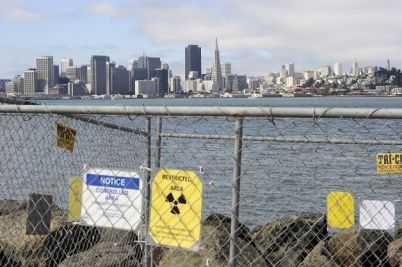[BIOCHEMISTRY | Week #12] Cell Biology + Radioactivity
Cell Biology + Radioactivity
I never really understood the extent of my exposure to radiation outside of a microwave oven or my own cell phone. The biggest surprise was the chart that showed how much radiation we are exposed to when traveling on an airplane. It never crossed my mind how being at higher elevations make you more susceptible to exposure to radiation from the sun. Wild! I was also left with such heavy thoughts about individuals in constant contact with high doses of radiation like those tasked to clean nuclear waste or those who work at power plants. The story one of our classmates shared about employees dying of cancer at a plant in Wisconsin was just heartbreaking. Is there a conversation happening around ethics and our excessive exposure to radioactive material? It seems that every scientific discovery and/or creation by humankind is easily bastardized by greed and power. Things seem to be worsening with the Trump administration’s push to manipulate public views on the serious impacts of radioactivity implying a little bit is good for us. The choice to prioritize profit over people’s health in this country is a pattern that constantly comes up in our Western Science class conversations. I wonder if we’ll live long enough to see a shift in those ideals from an institutional level.
Radioactive related cancer risk however is nothing new for poor, communities of color in the United States. We can look to our backyard of San Francisco. Historically (and presently) marginalized communities, predominantly Black and working class folks are pre-disposed to developing cancer and cancer related illness because of where they live. The Bayview-Hunters Point neighborhood of SF is a perfect example of that. For decades, community organizers, families and even physicians have expressed concern over toxic water and soil at the former Naval shipyards. It wasn't until 2018 in the midst of the SF's rapid re-development of housing in the area, where a radium device was discovered. Its the same old story. Prioritization of people's health and livelihood are disposable, unless they are of privileged backgrounds. You can check out the article here.
To further my studies on the biological impacts of radioactivity, I found this article on Cancer.gov. It was interesting (and hella scary) to learn about cancer risk related to nuclear accidents. I pray that we never have to experience what folks living in Fukushima and Chernobyl had to endure or even survivors of nuclear weapons used in war like in Vietnam and Japan.
FROM CANCER.GOV:
Radioactive related cancer risk however is nothing new for poor, communities of color in the United States. We can look to our backyard of San Francisco. Historically (and presently) marginalized communities, predominantly Black and working class folks are pre-disposed to developing cancer and cancer related illness because of where they live. The Bayview-Hunters Point neighborhood of SF is a perfect example of that. For decades, community organizers, families and even physicians have expressed concern over toxic water and soil at the former Naval shipyards. It wasn't until 2018 in the midst of the SF's rapid re-development of housing in the area, where a radium device was discovered. Its the same old story. Prioritization of people's health and livelihood are disposable, unless they are of privileged backgrounds. You can check out the article here.
To further my studies on the biological impacts of radioactivity, I found this article on Cancer.gov. It was interesting (and hella scary) to learn about cancer risk related to nuclear accidents. I pray that we never have to experience what folks living in Fukushima and Chernobyl had to endure or even survivors of nuclear weapons used in war like in Vietnam and Japan.
FROM CANCER.GOV:
What cancer risks are associated with nuclear power plant accidents?
Nuclear power plants use energy released by the decay of certain radioactive isotopes to produce electricity. Additional radioactive isotopes are produced during this process. In nuclear power plants, specially designed fuel rods and containment structures enclose the radioactive materials to prevent them, and the ionizing radiation they produce, from contaminating the environment. If the fuel and surrounding containment structures are severely damaged, radioactive materials and ionizing radiation may be released, potentially posing a health risk for people. The actual risk depends on several factors:
- The specific radioactive materials, or isotopes, released, and the quantities released.
- How a person comes into contact with the released radioactive materials (such as through contaminated food, water, air, or on the skin).
- The person’s age (those exposed at younger ages are generally at higher risk).
- The duration and amount of the exposure.
More information about the health effects of ionizing radiation exposure is available from the Centers for Disease Control and Prevention (CDC) and the Environmental Protection Agency.
The radioactive isotopes released in nuclear power plant accidents include I-131 and Cs-137. In the most severe kinds of accidents, such as the Chernobyl accident in 1986, other dangerous radioactive isotopes, such as strontium-90 (Sr-90) and plutonium-239, may also be released.
Human exposure to I-131 released from nuclear power plant accidents comes mainly from consuming contaminated water, milk, or foods. People may also be exposed by breathing dust particles in the air that are contaminated with I-131.
Inside the body, I-131 accumulates in the thyroid gland, which is an organ in the neck. The thyroid gland uses iodine to produce hormones that control how quickly the body uses energy. Because the thyroid does not distinguish between I-131 and nonradioactive iodine, the thyroid gland will accumulate either form. Exposure to radioactive iodine may increase the risk of thyroid cancer many years later, especially for children and adolescents.
Exposure to Cs-137 can be external to the body or internal. External exposure comes from walking on contaminated soil or coming into contact with contaminated materials at nuclear accident sites. Internal exposure can come from breathing particles in the air that contain Cs-137, such as dust originating from contaminated soil, or ingesting contaminated water or foods. Because Cs-137 is not concentrated in a particular tissue, the ionizing radiation that it releases can expose all tissues and organs of the body.



Comments
Post a Comment